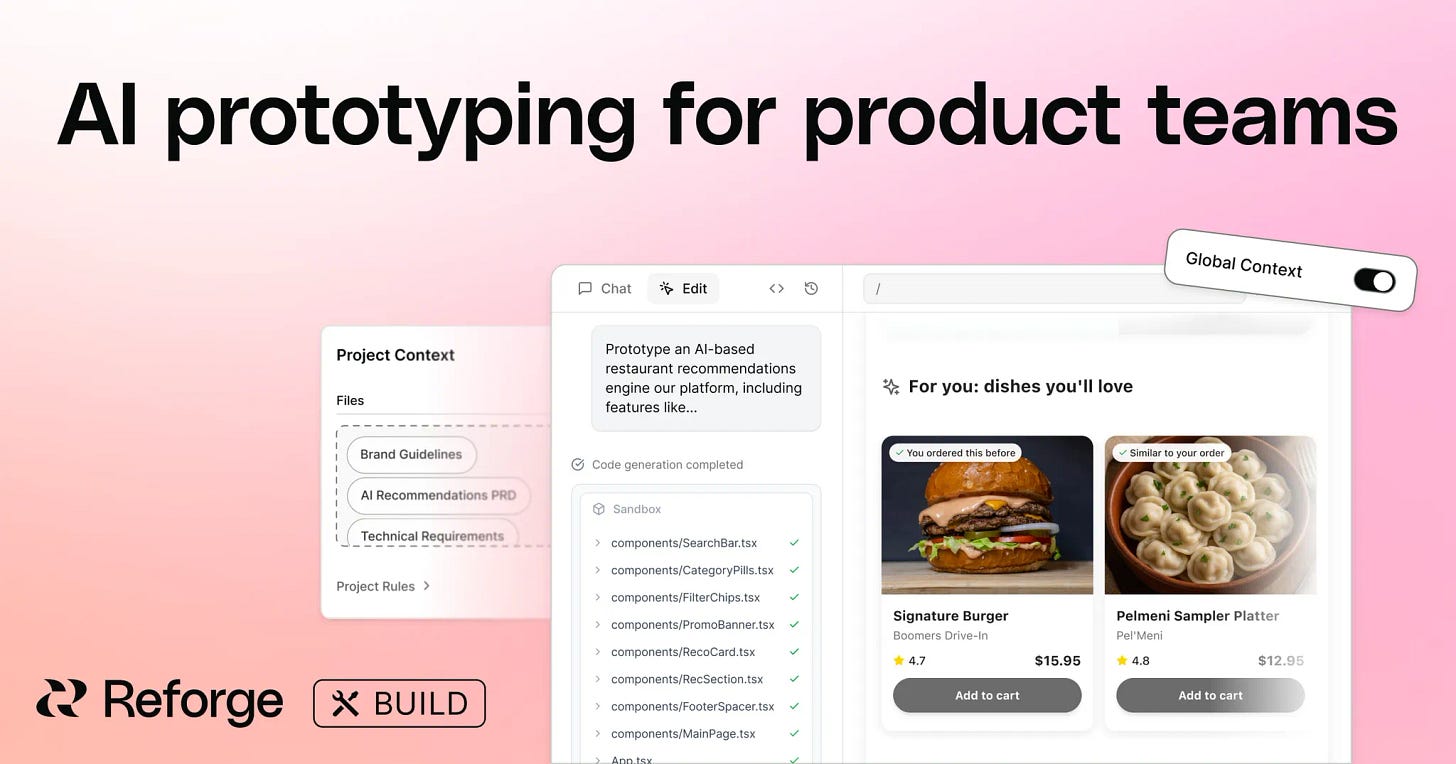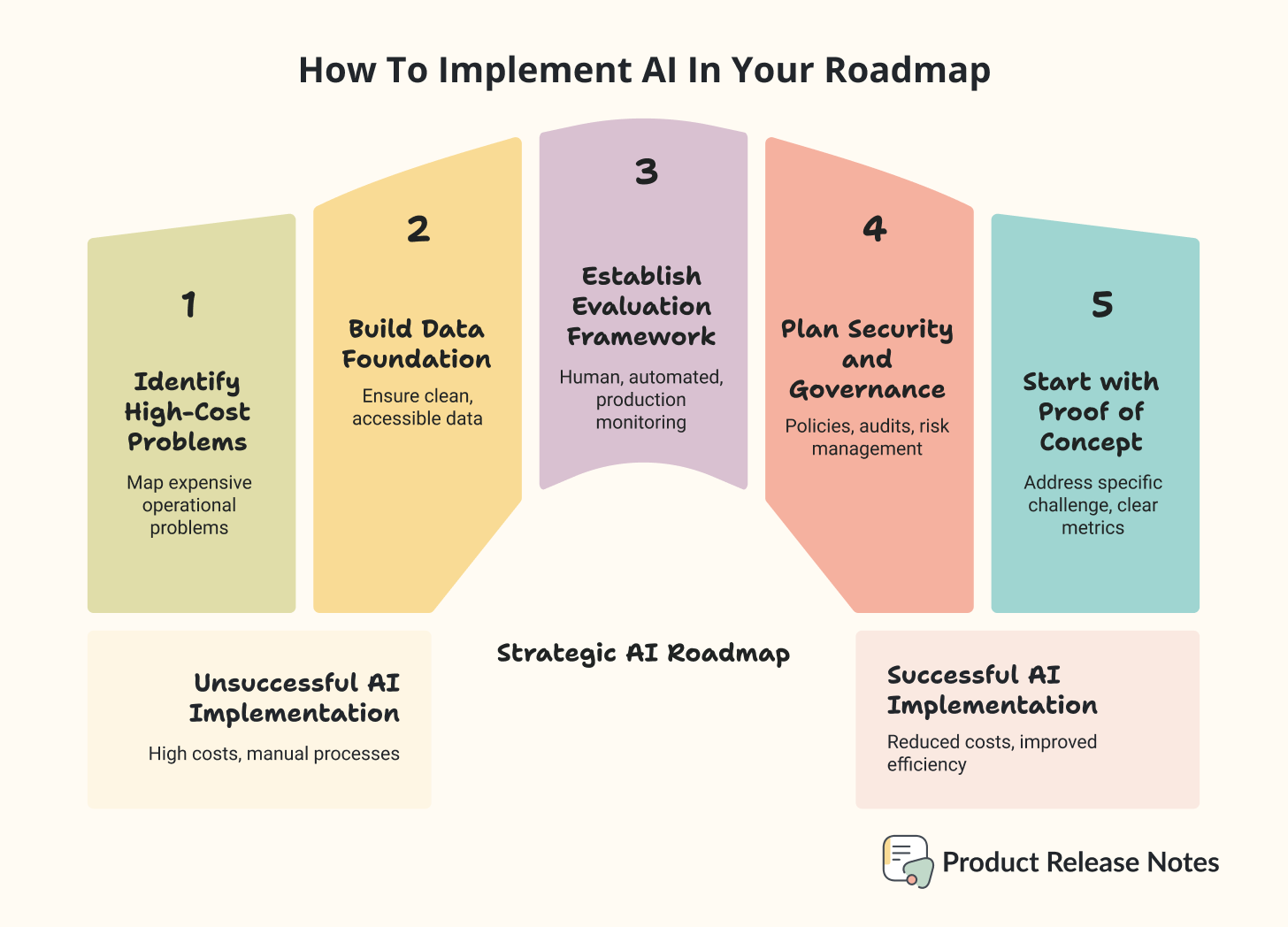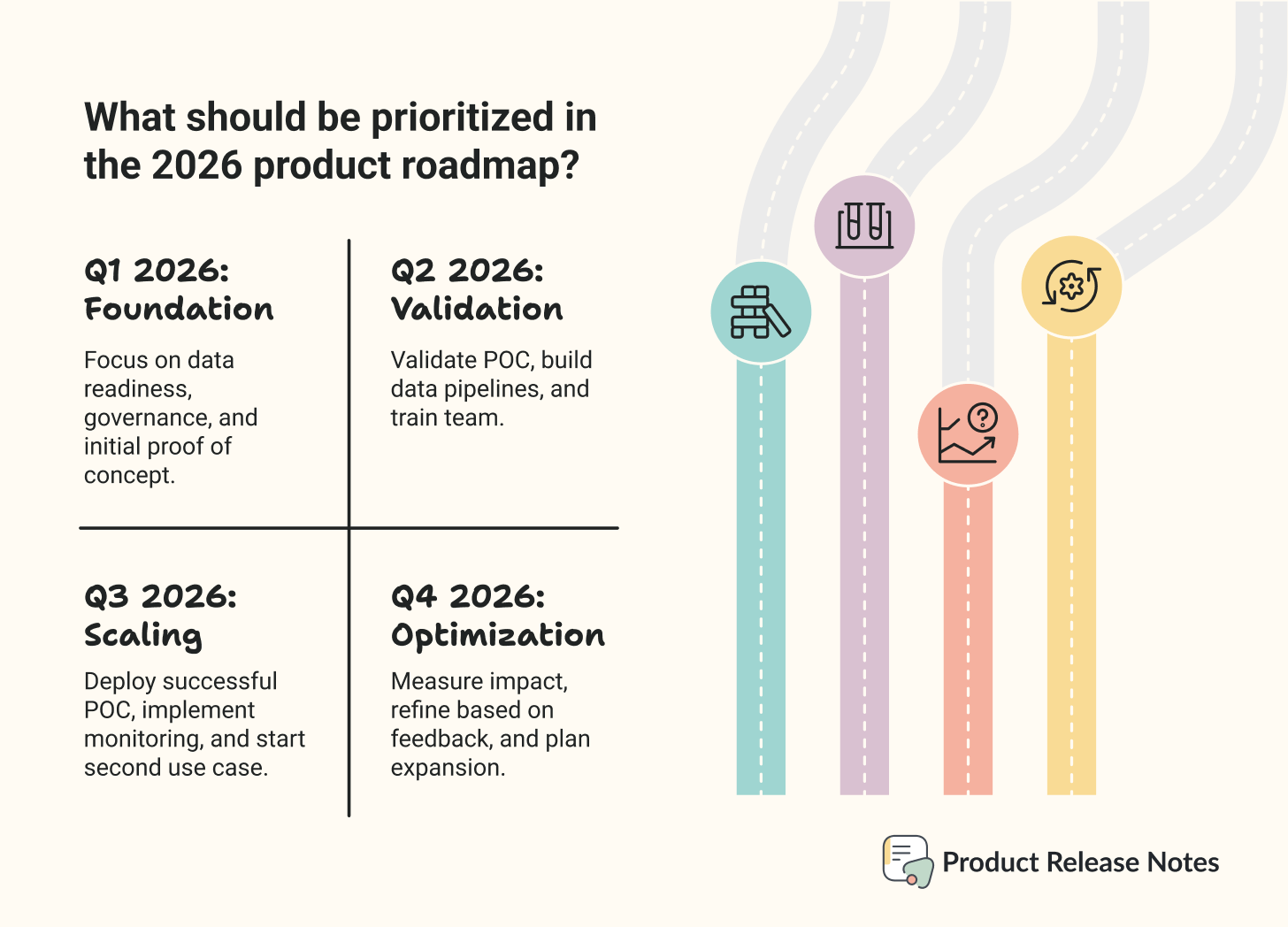How To Plan Your 2026 Product Roadmap With AI Without Bleeding Money
95% of AI pilots are failing and companies are burning $85K monthly. Here's the reality check every product leader needs before annual planning season destroys their budget and credibility.
Annual review season is here again, and AI is the elephant in every planning room. Everyone wants AI in their roadmap. Executives see competitors launching features. Investors ask about your AI strategy. Your team pitches ideas daily.
But here’s what nobody talks about: 42% of companies abandoned most of their AI initiatives in 2025, up dramatically from just 17% in 2024, according to S&P Global Market Intelligence. MIT researchers found that 95% of generative AI pilots are failing to deliver measurable business returns despite tens of billions in investment.
The problem isn’t AI itself. It’s how we’re approaching it.
The Real Cost Of Getting AI Wrong
Let me be clear about what’s at stake. According to CloudZero’s 2025 survey of 500 engineering professionals, the average monthly spend on AI jumped to $85,521 in 2025, a 36% increase from $62,964 in 2024. The proportion of organizations investing over $100,000 per month more than doubled from 20% to 45%.
That’s just the infrastructure costs. When you factor in AI talent with salaries ranging from $120,000 to $250,000 annually per specialist, data preparation consuming 60 to 80% of project time, and ongoing maintenance, the real numbers become sobering.
A mid-sized financial services company recently invested $175,000 in a custom AI fraud detection solution. Healthcare applications range from $20,000 to $50,000, while fintech applications can reach $50,000 to $150,000 due to complexity and regulatory requirements.
And here’s the part that should terrify you: Over 80% of AI projects fail, which is twice the failure rate of non-AI technology projects, according to RAND Corporation analysis.
The Three Mistakes That Kill AI Roadmaps
After analyzing dozens of failed implementations and talking to product leaders who’ve lived through the pain, three patterns emerge consistently.
Starting with solutions instead of problems.
Teams get excited about capabilities and forget to validate actual user needs. They build impressive demos that never scale into sustainable products.
MIT’s research shows companies succeeding with AI pick one specific pain point, execute well, and partner smartly. Those failing try to bolt AI onto broken processes.
Ignoring data readiness.
According to Informatica’s CDO Insights 2025 survey, data quality and readiness is the top obstacle cited by 43% of organizations. Companies spend an average of $1.2 million annually just on data management for AI initiatives, per IBM studies.
Without clean, organized, and labeled datasets consuming 60 to 80% of project time, your AI system cannot deliver value.
Skipping security and governance from day one.
IBM’s 2025 Cost of a Data Breach Report found that 13% of organizations reported breaches of AI models or applications, and shockingly, 97% of those compromised lacked AI access controls.
Gartner predicts that by 2027, more than 40% of AI-related data breaches will be caused by improper use of generative AI across borders.
According to Gartner research, only 48% of AI projects make it into production on average, and it takes 8 months to go from prototype to production. A well-structured POC reduces this waste dramatically.
Here’s the problem though. Most teams skip the prototype step entirely.
They debate the AI feature for weeks in planning meetings. They finally get stakeholder alignment. Engineering spends three months building it. Then they discover customers don’t actually want it that way.
This is why I’m partnering with Reforge Build (shoutout to ) this week. Their tool solves the specific prototyping gap that’s killing roadmap execution for product teams.
Instead of spending months building something to test an idea, you prototype first. And here’s what makes it actually useful for PMs. It starts from your existing product, not from scratch. The AI understands your product context, your customers, your strategy. You can test multiple variants before you commit engineering quarters.
For your 2026 roadmap specifically? Prototype your AI features before putting them in Q2 or Q3. Get customer feedback while you’re still in the planning phase, not after you’ve already spent $150,000 building the wrong solution.
My readers get one month of premium free. Code: BUILD → Try Reforge Build
Now, let’s break down how to structure your POC the right way...
How to Successfully Include AI In Your Roadmap
Successfully incorporating AI into your roadmap is easier than you might think. Product leaders who succeed with AI follow a different playbook. They don’t start with technology. They start with brutal prioritization.
Step 1: Identify Your Highest-Cost Problems
Begin your roadmap process by mapping your organization’s most expensive operational problems. Where are manual processes bleeding time? Which customer pain points drive the most support tickets? What decisions require extensive back-and-forth?
McKinsey’s 2025 AI survey confirms this pattern: organizations reporting significant financial returns are twice as likely to have redesigned end-to-end workflows before selecting modeling techniques.
A Fortune 500 client worked with Beam AI to overhaul customer operations. Within 90 days, average case resolution time dropped 71%, manual workload reduced 63%, and Net Promoter Score improved 18 points. The key was targeting a specific, measurable problem rather than exploring AI broadly.
Step 2: Build Your Data Foundation First
Before you commit to any AI feature on your 2026 roadmap, audit your data reality. Winning programs allocate 50 to 70% of their timeline and budget for data readiness, including extraction, normalization, governance metadata, quality dashboards, and retention controls.
Ask these questions during planning:
Do we have historical data for the problem we want to solve?
Is our data clean, labeled, and accessible?
Do we have the infrastructure to store and process this data securely?
Have we mapped our data governance and compliance requirements?
🚨 If you’re answering no to these questions, put data infrastructure on your roadmap before AI features. Otherwise you’re building on sand.
Step 3: Establish Your Evaluation Framework
This is where most product roadmaps fail spectacularly. As Kevin Weil, CPO of OpenAI, stated:
“Writing evals is going to become a core skill for product managers. It is such a critical part of making a good product with AI.”
Your evaluation framework should include:
Human evaluations for high-stakes decisions and establishing quality standards. Actual users or expert evaluators provide direct feedback on AI outputs through mechanisms like thumbs up/down buttons or rating scales.
Automated evaluations that scale cost-effectively. Using another LLM to evaluate your primary system’s outputs based on defined criteria.
Production monitoring that tracks drift and degradation. Systems need to continuously check if AI performance is declining over time.
Without systematic evaluation, you’re playing whack-a-mole with problems. Build your evaluation system into your roadmap from day one, not as an afterthought.
Step 4: Plan For Security and Governance
According to IBM’s research, 63% of breached organizations either don’t have an AI governance policy or are still developing one. Only 34% of those with policies perform regular audits for unsanctioned AI use.
Your 2026 roadmap must include:
AI governance policies with clear guidelines for acceptable use
Regular audits for shadow AI (one in five organizations reported breaches due to shadow AI)
Trust, risk, and security management products tailored to AI technologies
Data encryption for both data in transit and at rest
Multi-factor authentication for AI model and training data access
Gartner predicts that by 2026, enterprises applying AI trust, risk, and security management controls will consume at least 50% less inaccurate or illegitimate information.
Step 5: Start With Proof of Concept, Not Production
Rather than committing your entire 2026 budget to unproven AI features, structure your roadmap in phases. Effective proof of concepts typically cost $50,000 to $150,000 and deliver valuable insights that improve full implementation success rates.
Your POC should:
Address one specific business challenge
Run for 8 to 12 weeks maximum
Have clear success metrics defined upfront
Include evaluation systems from day one
Involve engineering teams from the beginning
The Budget Reality Check
When planning your 2026 AI investments, here’s a realistic budget framework based on 2025 data:
For simple AI implementations with limited functionality: $50,000 to $150,000
For mid-range departmental deployments: $150,000 to $500,000
For enterprise-level organization-wide implementations: $500,000+
But remember, these are just development costs. Factor in:
Monthly infrastructure costs: $2,000 to $30,000 for cloud-based solutions
AI talent: $120,000 to $250,000 annually per specialist
Ongoing maintenance: typically 17% to 22% of initial development cost annually
Data management: averaging $1.2 million annually for substantial initiatives
Security and compliance tools: adding 25% to 35% to base costs
Companies using AI and automation extensively save an average of $1.9 million in breach costs and reduce breach lifecycles by 80 days. But this only happens when security is built in from the start.
What To Put On Your Roadmap
Your 2026 roadmap should balance ambition with reality. Here’s what successful product leaders are prioritizing:
Q1 2026: Foundation and Assessment
Conduct data readiness audit
Establish AI governance framework
Build evaluation infrastructure
Launch small proof of concept with clear metrics
Q2 2026: Validate and Learn
Complete POC and measure results
Build production-grade data pipelines
Train team on AI evaluation practices
Document lessons and failure modes
Q3 2026: Scale What Works
Deploy successful POC to production
Implement monitoring and alerting systems
Begin second use case based on learnings
Establish ROI tracking mechanisms
Q4 2026: Optimize and Expand
Measure business impact across metrics
Refine based on production feedback
Plan expansion to adjacent use cases
Budget for 2027 based on proven returns
The Questions To Ask Before Committing
Before you lock in AI features for 2026, pressure test your roadmap with these questions:
Have we validated this solves a real user problem worth solving?
Do we have the data infrastructure to support this?
Can we measure success objectively with our evaluation framework?
Have we budgeted for security, governance, and ongoing costs?
Does our team have the skills, or do we need to hire?
What happens if this fails - do we have a kill switch?
If you can’t answer these confidently, you’re not ready for that feature yet!
Final Thoughts
AI adoption is moving faster than AI maturity. The companies winning aren’t the ones with the most ambitious AI roadmaps. They’re the ones being ruthlessly practical about what they build and when.
Your 2026 roadmap doesn’t need 47 AI initiatives. It needs three or four well-chosen problems where AI delivers measurable value, backed by proper data infrastructure, evaluation systems, and security from day one.
The goal isn’t to have AI in your product. The goal is to solve real problems better than before. AI is just the tool.
Remember: 95% of generative AI pilots are failing not because of model quality, but because of execution fundamentals. Your competitive advantage in 2026 won’t come from having AI. It will come from having AI that actually works.
Start with one problem. Build the foundation right. Measure everything. Then scale what proves valuable.
What problems are you considering adding AI to in your 2026 roadmap? What concerns do you have about implementation?
Two things before you go:
If you’re ready to start prototyping those roadmap ideas, my readers get one month of Reforge Build premium free. Code: BUILD → Try it here
And if you want to sharpen your AI skills before annual planning kicks off, join my free 25-day AI Advent Challenge starting December 1st. Daily hands-on exercises that actually make you better at this stuff → Sign up here





